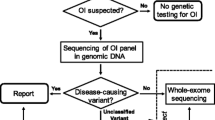Abstract
Osteogenesis imperfecta is a rare genetic connective tissue disorder. It is characterized by increased bone fragility, dentigerous imperfecta, and generalized ligamentous laxity. The incidence is one in 15,000 live births. The basic defect is in the formation of type 1 collagen. Children with OI have blue sclera, short stature, hearing impairment, and an increased tendency for fractures and deformities during childhood. The manifestations of these clinical features vary according to the type of disease. OI is divided into four types based on phenotypic severity: mild (Type I), moderate (Type IV), severe (Type III), and perinatally lethal (Type II) by Sillence (Table 1). Spine deformities are seen in more than 50% of cases of OI. Milder varieties have a dominant mutation in the COL1 A1 and COL1 A2 genes. Recessive varieties are severe. The diagnosis of OI is clinical although sometimes requires a skin biopsy, and DNA sequencing can help in classification [1].
Access this chapter
Tax calculation will be finalised at checkout
Purchases are for personal use only
Similar content being viewed by others
References
Wallace MJ, Kruse RW, Shah SA. The spine in patients with osteogenesis imperfecta. J Am Acad Orthop Surg. 2017;25(2):100–9. https://doi.org/10.5435/jaaos-d-15-00169.
Renshaw TS, Cook RS, Albright JA. Scoliosis in osteogenesis imperfecta. Clin Orthop Relat Res. 1979;(145):163–167. https://doi.org/10.1097/00003086-197911000-00022.
Anissipour AK, Hammerberg KW, Caudill A, Kostiuk T, Tarima S, Zhao HS, Krzak JJ, Smith PA. Behavior of scoliosis during growth in children with osteogenesis imperfecta. J Bone Joint Surg Am. 2014;96:237–43. https://doi.org/10.2106/jbjs.l.01596.
Widmann RF, Bitan FD, Laplaza FJ, Burke SW, DiMaio MF, Schneider R. Spinal deformity, pulmonary compromise, and quality of life in osteogenesis imperfecta. Spine (Phila Pa 1976). 1999;24(16):1673. https://doi.org/10.1097/00007632-199908150-00008.
O’Donnell C, Bloch N, Michael N, Erickson M, Garg S. Management of scoliosis in children with osteogenesis imperfecta. JBJS Rev. 2017;5(7):e8. https://doi.org/10.2106/jbjs.rvw.16.00063.
Karlin LI, McClung A, Johnston CE, et al. The growth-friendly surgical treatment of scoliosis in children with osteogenesis imperfecta using distraction-based instrumentation. Spine Deform. 2021;9(1):263–74. https://doi.org/10.1007/s43390-020-00196-0.
Piantoni L, Noel MA, Francheri Wilson IA, et al. Surgical treatment with pedicle screws of scoliosis associated with osteogenesis imperfecta in children. Spine Deform. 2017;5(5):360–5. https://doi.org/10.1016/j.jspd.2017.03.002.
Velisavljev-Filipovic G. Arthrogryposis multiplex congenita—a rare congenital stiff joints syndrome. Med Pregl. 2006;59(7–8):375–9. https://doi.org/10.2298/mpns0608375v.
Drummond DS, MacKenzie DA. Scoliosis in arthrogryposis multiplex congenita. Spine. 1978;3(2):146–51. https://doi.org/10.1097/00007632-197806000-00009.
Latypova X, Creadore SG, Dahan-Oliel N, et al. A genomic approach to delineating the occurrence of scoliosis in arthrogryposis multiplex congenita. Genes. 2021;12(7):1052. https://doi.org/10.3390/genes12071052.
Xu L, Chen Z, Qiu Y, et al. Case-matched comparative analysis of spinal deformity correction in arthrogryposis multiplex congenita versus adolescent idiopathic scoliosis. J Neurosurg Pediatr. 2019;23(1):22–9. https://doi.org/10.3171/2018.7.peds18347.
Yingsakmongkol W, Kumar SJ. Scoliosis in arthrogryposis multiplex congenita: results after nonsurgical and surgical treatment. J Pediatr Orthop. 2000;20:656–61. https://doi.org/10.1097/00004694-200009000-00021.
Yılmaz A, Acar HV, Tezer E, Demir G, Başar H. Anesthesia for scoliosis surgery in a patient with arthrogryposis multiplex congenita. J Clin Exp Invest. 2013;4(1):113–5. https://doi.org/10.5799/ahinjs.01.2013.01.0246.
Komolkin I, Ulrich EV, Agranovich OE, van Bosse HJP. Treatment of scoliosis associated with arthrogryposis multiplex congenita. J Pediatr Orthop. 2017;37(Supplement 1):S24–6. https://doi.org/10.1097/bpo.0000000000000993.
Herron LD, Westin GW, Dawson EG. Scoliosis in arthrogryposis multiplex congenita. J Bone Joint Surg Am. 1978;60(3):293–9. https://doi.org/10.2106/00004623-197860030-00003.
Greggi T, Martikos K, Pipitone E, et al. Surgical treatment of scoliosis in a rare disease: arthrogryposis. Scoliosis. 2010;5(1):24. https://doi.org/10.1186/1748-7161-5-24.
Xu L, Luan W, Wang Y, et al. Improvement of pulmonary function in arthrogryposis multiplex congenita patients undergoing posterior spinal fusion surgery for concomitant scoliosis: a minimum of 3-year follow-up. World Neurosurg. 2022;157:e424–31. https://doi.org/10.1016/j.wneu.2021.10.115.
Kirkland JD. Osteopetrosis—classic imaging findings in the spine. J Clin Diagn Res. 2015;9:TJ01. https://doi.org/10.7860/jcdr/2015/13334.6348.
Westerlund LE, Blanco JS, Chhabra A. Posterior spinal instrumentation and fusion of a neuromuscular scoliosis in a patient with autosomal dominant osteopetrosis. Spine (Phila Pa 1976). 2000;25(2):265. https://doi.org/10.1097/00007632-200001150-00020.
Amirfeyz R, Clark C, Gargan M. Spondyloepiphyseal dysplasia. Curr Orthop. 2005;19(4):309–13. https://doi.org/10.1016/j.cuor.2005.06.007.
Morita M, Miyamoto K, Nishimoto H, Hosoe H, Shimizu K. Thoracolumbar kyphosing scoliosis associated with spondyloepiphyseal dysplasia congenita: a case report. Spine J. 2005;5(2):217–20. https://doi.org/10.1016/j.spinee.2004.08.002.
Author information
Authors and Affiliations
Corresponding author
Editor information
Editors and Affiliations
Rights and permissions
Copyright information
© 2023 The Author(s), under exclusive license to Springer Nature Singapore Pte Ltd.
About this chapter
Cite this chapter
Zacharia, B. (2023). Rare Causes of Scoliosis in Children: A Bird’s Eye View. In: Zacharia, B., Raja, S.D.C., KV, N. (eds) Paediatric Scoliosis . Springer, Singapore. https://doi.org/10.1007/978-981-99-3017-3_38
Download citation
DOI: https://doi.org/10.1007/978-981-99-3017-3_38
Published:
Publisher Name: Springer, Singapore
Print ISBN: 978-981-99-3016-6
Online ISBN: 978-981-99-3017-3
eBook Packages: MedicineMedicine (R0)




